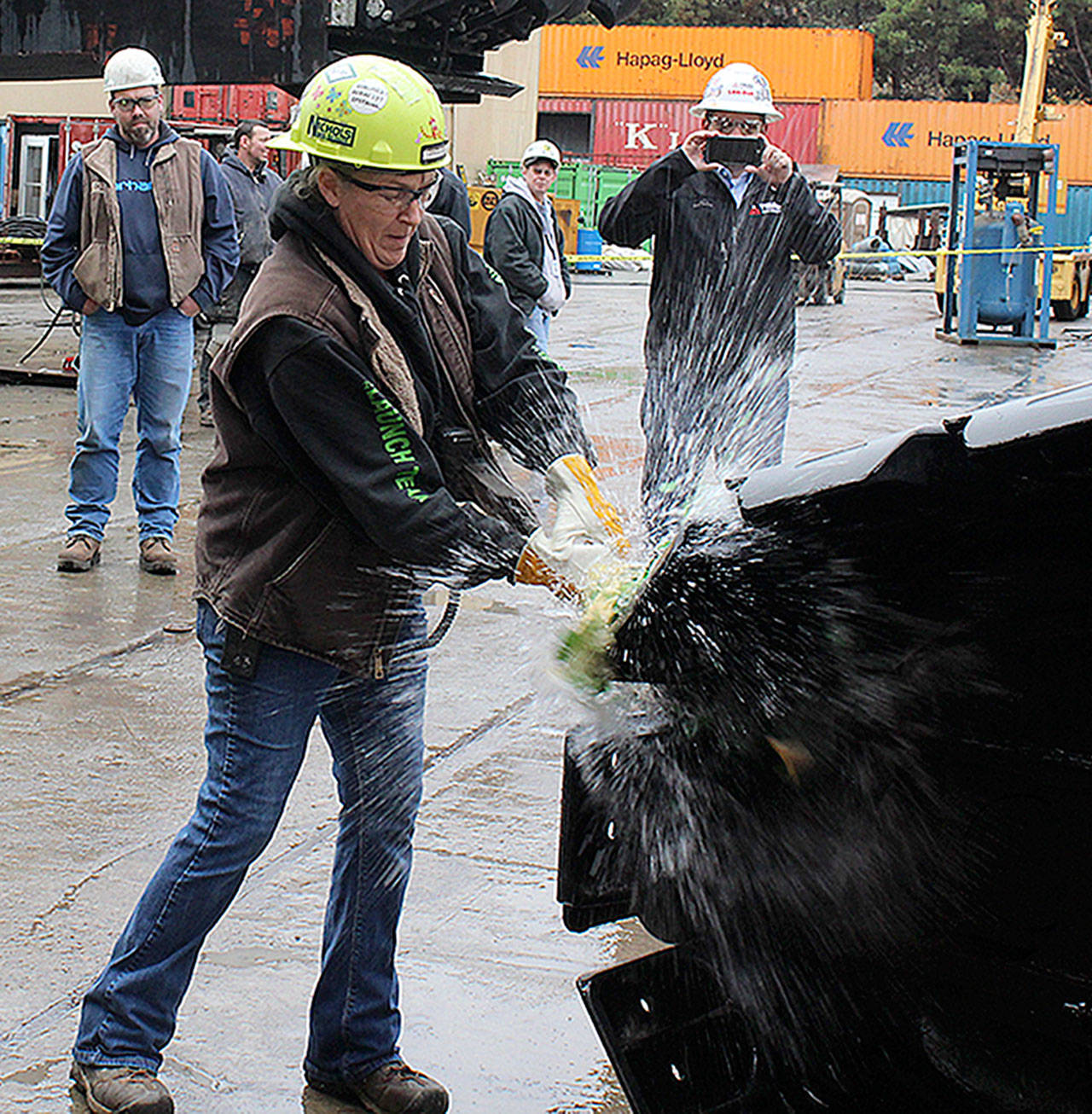The crack of a champagne bottle sounded at Nichols Brothers Boat Builders Friday as the Freeland shipyard celebrated a new piece of equipment that could boost business.
A tall and mighty crane, looming 210-feet feet in the air, and able to lift 250 tons, came as an early Christmas present from the federal government.
Costing $1.8 million, about 75 percent of its costs were paid for under a grant program designed to assist stable shipyards with capital improvements.
“This is like buying yourself a brand new Tesla for the price of a used Camry,” said Kevin Corrigan, human resources director. “It’s going to result in not only being able to build bigger modules, but you’ll be able to do more and work more efficiently,” he told a gathering of some 200-plus workers who were treated to pizza and then a few speeches.
“It’s an opportunity to grow the business,” he added. “Let this crane enter into decades of more hard work at Nichols Brothers Boat Builders.”
Administered under the U.S. Department of Transportation’s’ Maritime Administration Small Shipyard Grant Program, Nichols Brothers was among 29 companies selected from 100 applicants to split up nearly $20 million.
The program started about a decade ago to give shipyards a boost following the recession.
“These grants are an investment in our country’s small shipyards and will help create good jobs for America’s workers,” U.S. Transportation Secretary Elaine L. Chao said in a press release.
Matt Nichols, president of the company, said the new crane will lead to more jobs because it allows bigger vessels to be constructed and because it increases productivity.
His grandfather, George Mark Nichols started building ships in Oregon in the 1930s. Matt’s father, Frank Nichols, then opened his own shipyard in Freeland in 1964.
America’s shipyards support more than 400,000 jobs and contribute more than $37 billion in gross domestic product to the nation’s economy, according to the agency press release.
Small shipyards vary in size but must have fewer than 1,200 production employees to be eligible for the program. Nichols Brothers employs about 340 people.
Kyle Stratia, crane supervisor, said the shipyard has been relying on a much smaller crane that is able to lift 150 tons.
As ships are built into modules, a crane lifts them into place and construction continues, he explained. A bigger crane that’s able to lift bigger and heavier sections means the modules can be built out farther, which is more efficient.
“We’ve been handicapped by the smaller crane,” Stratia said. “This allows us to really bump up capacity. It will save a whole lot of hours.”
The giant machine, built by Link Belt Cranes, is a 250-ton lattice boom crawler crane that has a reach of 190 feet.
“It’s 190 feet of main boom with 220,000 pounds of counterweight,” said Brian Elkins, crane business manager with distributor Triad Machinery.
Nichols Brothers, now owned by Ice Floe, LLC, is the first shipyard in the Pacific Northwest to purchase the 298HSL crane, Elkins pointed out.
Before christening the crane dubbed the “White Stallion,” Nichols updated workers on the status of incoming orders, which include high-speed passenger ferries and a tugboat.
“We’ve got a great yard and we’ve got great people,” he told the hard-hatted hundreds who were huddling under a huge tent from the rain and cold.
“It’s the people who are everything. Without you, we’ve got nothing.”
Geri Downey, who sports the nickname “Mama” on her hard hat, then whacked the bottle across the bow of this crane, successfully shattering the symbolic bottle.
“Clean up,” she yelled, joking, as that’s the command she responds to on the clean-up crew.
The whole occasion seemed rather ironic because this is a shipyard that never christens its own ships. Nichols explained that the ceremony is left for the buyers of the mighty vessels after the transfer of ownership.
“But this is our crane,” Nichols said.
“And it stays here.”



